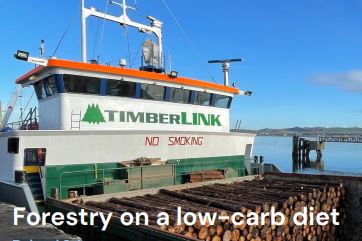FWN39 Spring 2023 – Forestry on a Low-Carb Diet
31 March 2023The role of forests in helping Scotland meet our Net Zero targets is one of the main drivers of forestry policy. Scotland’s forests are a large store of carbon and there are government targets to further expand our forest area through new planting.
Involving farmers in this endeavour is key to creating a forest resource that is sensibly integrated into our productive landscapes and our rural economy. Woodland on farms can provide income from timber, local biomass energy, shelter for wildlife, crops and livestock, as well as biodiversity and carbon gains.
A recent Forest Research report on Quantifying The Sustainable Forestry Carbon Cycle (i) shows that all types of woodland creation in the UK will sequester similar amounts of carbon in the long term, although conifer forests tend to absorb more in the short term. While the forests we plant for timber are harvested after about 30 years, both the timber they produce and the next rotation of planted forest will continue to store carbon and add considerably to reducing our net emissions.
One way to help decarbonise our economy is to help develop markets that store home-grown timber in long lived products – like houses. If we can build homes that are more ‘timber rich’ we will not only store carbon but also displace concrete, brick and steel – all of which require lots of fossil fuel energy to produce. However, like much of our economy the forest and timber supply chain is still very dependent on diesel to power the tractors, diggers, harvesting machines, lorries, loaders and some of the nursery and sawmilling equipment. Like agriculture, forestry is feeling its way regarding how to do this in practice. There will be scope for learning from both sectors.
Last summer the Timber Transport Forum produced a Road Haulage Decarbonisation Overview Report (ii) setting out the possible pathways to decarbonisation. Carbon Exchange (iii) has produced a more detailed report, on the challenges of addressing the estimated 45,000 mobile machines in Scottish agriculture.
We can fairly readily switch diesel engines to using biofuels, such as hydrotreated vegetable oil (HVO), or biogas and the new battery electric or hydrogen fuel cell technologies are becoming technologically feasible even for heavier machinery.
Prototype electric harvesting machines are already appearing in the trade shows and Scottish Forestry is working with the sector to pilot a couple of electric timber lorries next year. As more of the electricity in our grid is produced from renewable sources the gains from shifting to electricity will become even greater. Making sure we have high power charging infrastructure in place is something we all need to start looking at. Even on industrial estates it is not always straightforward to secure sufficient power for a 150kW lorry charger.
Haulage from coastal forests is moving to shipping, which not only takes lorries off the roads but also tends to be more energy efficient (for now). Scottish Forestry supports the Timberlink shipping service that moves timber from Argyll across the Firth of Clyde to Ayrshire where there is a concentration of processors. Many of our sawmills, boardmills and paper mills now use recycled timber, forest residues and offcuts to provide heat and electricity n their processes. Timber inevitably has to move around – our large forest resources will always be some way from the large centres of demand
However there remains scope to shorten supply chains – to process wood and add value locally and to supply our own markets with local timber wherever possible. Growing productive woodlands at appropriate scale in the farming landscape will help make this more possible.
Roland Stiven
Forest Sector Development Advisor, Scottish Forestry
i Quantifying the sustainable forestry carbon cycle (forestresearch.gov.uk)
ii Decarbonisation-of-Timber-Haulage-Report-2022.pdf (timbertransportforum.org.uk)
iii Decarbonisation of mobile agricultural machinery in Scotland – an evidence review (climatexchange.org.uk)
Image from Associated British Ports
Sign up to the FAS newsletter
Receive updates on news, events and publications from Scotland’s Farm Advisory Service

